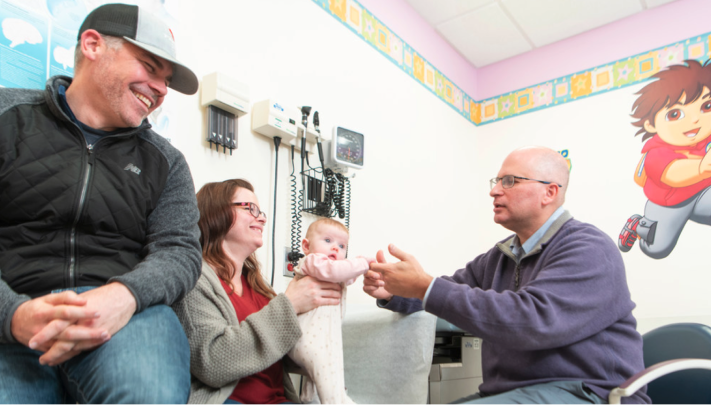A cloaca is the most complex of anorectal malformations. They occur in approximately 1 in 50,000 live births of female fetuses. Children with this type of rare congenital anomaly are born with a single channel instead of three separate openings for the rectum, vagina and urinary tract. The degree of severity depends on where the three tracts have joined together.
Due to their complexity, cloacal malformations require multidisciplinary treatment from pediatric surgeons, urologists and gynecologists. Children diagnosed with this condition may also have anomalies in other organ systems and will likely require several different types of reconstructive surgeries. Depending on the severity of their condition, treatment may involve urinary, vaginal and colorectal reconstruction. Having a detailed understanding of the anatomy of the malformation is critical when creating a surgical plan for each patient.
Children with this congenital anomaly require long-term, continued follow-up care as this condition can increase the risk of developing certain urological, gynecological and colorectal conditions later in life.
Clinical Presentation of Cloacal Malformations
Newborn babies with cloacal malformations have a single perineal orifice. Children may also exhibit symptoms such as:
- Abdominal swelling
- Enlarged kidneys
- Having only one kidney
- Hydrocolpos — a condition causing fluid to back up in the vagina and uterus, which can cause a blockage of the ureters
- Urine that backs up into the kidneys (reflux)
Diagnosing Children with Cloacal Malformations
In most cases, making a definitive diagnosis requires a thorough physical examination and various diagnostic tests after the infant is born. In some cases, the use of a prenatal ultrasound may be effective at making a diagnosis prior to birth.
When evaluating a newborn with a suspected cloacal malformation, the following diagnostic tests are recommended:
- Abdominal ultrasound: to examine the kidneys, bladder and pelvic organs
- Spinal ultrasound: to evaluate for spine abnormalities or other neurological problems
- X-rays: to examine the spine and sacrum
- Voiding cystourethrogram (VCUG): to evaluate a child’s urethra and bladder size, shape and capacity
Once newborns have been treated for any life-threatening anomalies and are stabilized, they can undergo more comprehensive physical examinations, including a thorough urologic assessment. After the child has reached three months of age, a more comprehensive diagnosis may include an MRI to obtain high-definition images of the spine and pelvis. An endoscopic examination and a cloacagram (contrast study) are done which allows the team to attain a more detailed anatomical understanding of the malformation.
Congenital Abnormalities Associated with Cloacal Malformations
Infants with cloacal malformations can have abnormal development in other body systems. Some children may also be diagnosed with VACTERL association and have anomalies in at least three of the following body systems:
V: vertebral
A: anorectal
C: cardiac
T: tracheoesophageal fistula
E: esophageal
R: renal
L: limb
Spinal and sacral anomalies are also common in children with cloacal malformations. These include a tethered cord and sacral agenesis.
Post Operative Problems After Surgery for Cloacal Malformations
Recovery from cloacal malformation reconstructive surgery will typically require several or more days in the hospital. After surgery, the colostomy bag remains in place until everything has healed. This can be closed one to three months later, and the cloacal repair can be inspected at the same time. After this procedure, the child is observed for voiding of urine and passing of stool.
Constipation is common after surgery, which is easy to treat with a small amount of a daily laxative. Children treated for cloacal malformations should be monitored closely to make sure any issues with constipation do not develop into fecal impaction or incontinence. Patients may benefit from participating in Children National’s bowel management program. After children complete this program, they should be followed closely in case their established regimen needs to be adjusted.
In addition to management of constipation and fecal incontinence, it is vital to ensure good bladder emptying and successful voiding to keep the kidneys healthy. Children with cloaca are more likely to develop urinary tract infections and urinary incontinence. With good bladder emptying and techniques, such as intermittent catheterization for urine, these symptoms can be dramatically reduced.
Long-term Outcomes for Children with Cloacal Malformations
Because children treated for cloacal malformations have an increased risk of certain urological, gynecological and colorectal conditions later in life, they require long-term, continued follow-up care. Some patients, for example, may experience constipation, urinary tract infections and fecal and urinary incontinence. If not treated promptly, these conditions can result in more serious medical problems, such as soiling or kidney damage. Any established treatment regimen should be periodically evaluated and adjusted as necessary. Some patients may also need additional surgeries later in life. It’s important that practitioners educate parents about possible long-term outcomes and the need for further treatment or surgery.
Patients and their parents should also receive gynecologic counseling before the onset of puberty to discuss any gynecologic issues they might face in the future, such as those affecting menstruation, sexual function and fertility. Most patients with cloaca can become pregnant, however they will need to have a Cesarean section at delivery.
Around the ages of 11 and 12, patients and their families should start planning a transition to adult providers in urology, gynecology, and colorectal experienced in treating patients living with anorectal malformations. Adolescents with this condition may also develop issues with body self-image and sexual function and may benefit from psychological support.
The Future of Treatment for Cloacal Malformations
Because children with this condition may face complex health issues, studies have shown that a collaborative approach to care amongst specialists results in better health outcomes. As children become adults, it is critical that they continue to receive long-term, specialized care under a multidisciplinary team with expertise in this condition.




